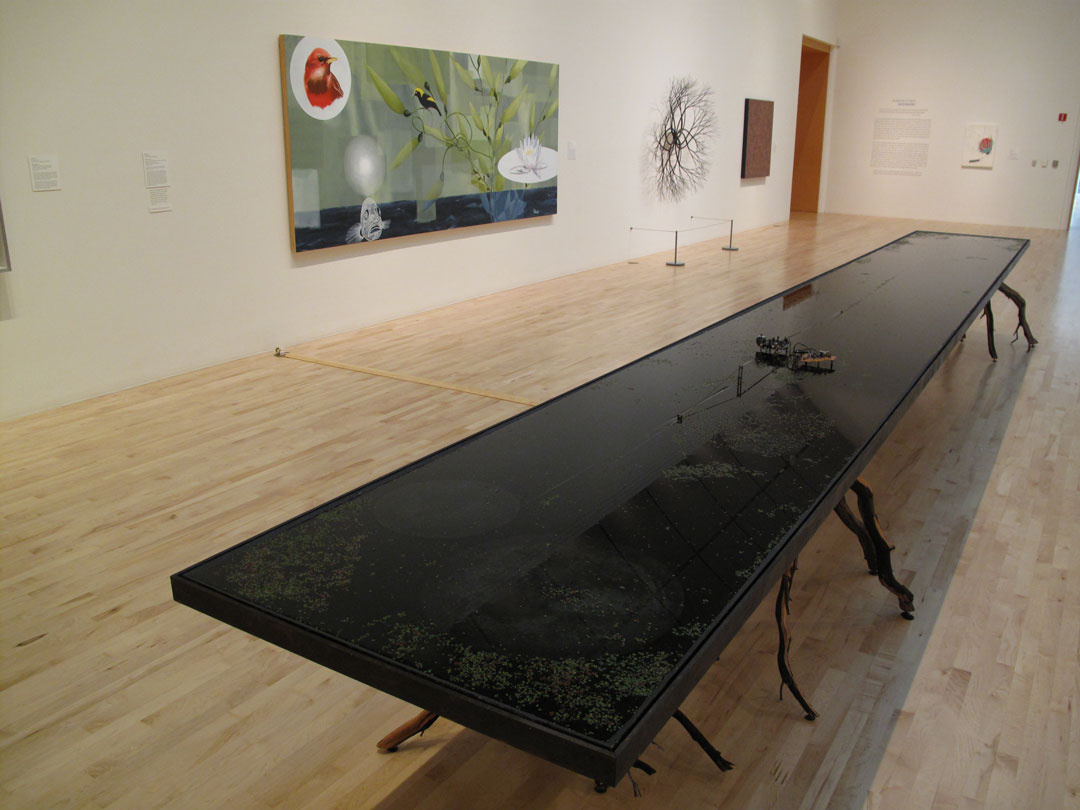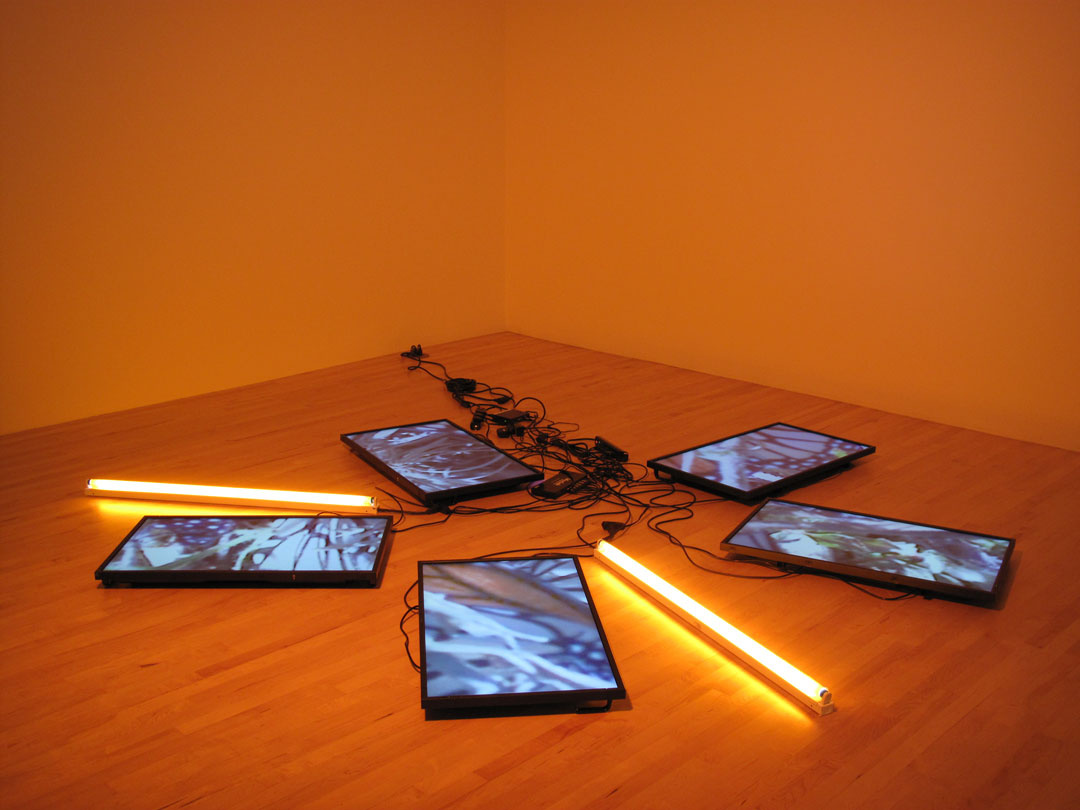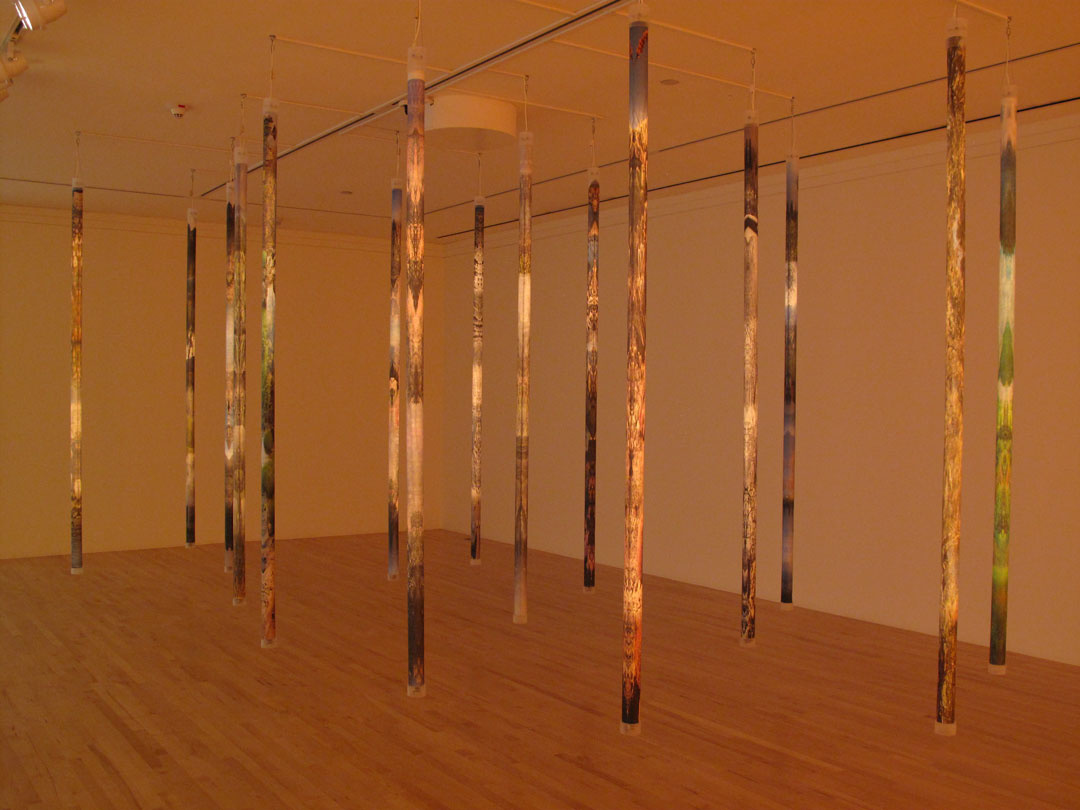Reflection

Watertable, 2016
Wood, steel, manzanita branhes, water, India ink, duckweed, electronics, audio, tape, and sound, 288 × 36 × 30 inches
Commissioned by the San Jose Museum of Art
Evan Holm
Born 1980, Seattle, Washington
Lives and works in Oakland, California
W.S. Merwin’s poems “The Search” and “Deception Island” appear in Migration: New & Selected Poems (2005), and are used by permission of Copper Canyon Press.
Evan Holm harmonizes nature and machine in large-scale kinetic and sonic sculptures that mimic landscapes. Holm’s carefully constructed built environments contain what he calls “repositories for human narrative”—artifacts that evidence human culture, artistic expression, and curiosity with the world—that emerge from the passage of time. To create WaterTable, Holm used dead manzanita branches, scorched by the devastating “Rim Fire” of 2013 in the Sierra foothills of central California, to anchor a rectangular pool of water like roots running into the ground. Submerged beneath the murky water, several spools of audiotape spin instrumental songs and recordings of W.S. Merwin reading his poems that rouse feelings of melancholy and nostalgia for the environment. The gentle currents cause the duckweed floating along the surface of the water to shift and coalesce into tiny configurations like cells or atoms.
Watch a video documentation of the work-in-progress in the artist’s studio: https://vimeo.com/177610294

Untitled (Mud Animal), 1999
Stuffed animals, mud, furry bathrobes, and wood stool, 46 × 33 × 24 inches
Museum purchase with funds contributed by the Museum's Collection Committee and Beverly and Peter Lipman
Kathryn Spence
Born 1963, Stuttgart, Germany
Lives and works in San Francisco, California
An avid birder, gardener, and naturalist, Kathryn Spence exposes a subtle disconnect between nature and the culture of consumerism. She transforms cast-off items and debris into objects of social and ecological portent. Spence’s “mud animals”—made from discarded stuffed animals, old bathrobes, and layers of dirt—assume the drooping posture of a collapsed teddy bear. Whether this ubiquitous childhood companion evokes feelings of defeat, dejection, or abandonment, affection for the object calls “attention to the inseparable connection between the physical and psychological in everyday life.” Spence elaborated, “I want [the mud animals] to seem weathered, like they’re decomposing…we need to be in touch with dirt.” Through these somber, introspective objects, Spence shares her larger conviction: humanity and nature are equally fragile, vulnerable subjects.

Untitled (Butterfly Videowall #2), 2008
Five flat screen LCD monitors, BrightSign player with SD card, HDMI splitter, two fluorescent light fixtures, and Lee filters, Dimensions variable, Edition 1 of 1
Museum purchase with funds contributed by the Acquisitions Committee with additional funds provided by the Lipman Family Foundation
Diana Thater
Born 1962, San Francisco, California
Lives and works in Los Angeles, California
Diana Thater often takes an animal’s interactions with its environment as a starting point to investigate ideas of space and time, believing that her work as an artist “is about rethinking the environment…rethinking how other beings live in the world…to change the way people see the world.” Prompted by threats to the monarch butterfly’s winter home in Michoacán, Mexico, Thater filmed the quick, bright movements of a single butterfly at the El Rosario Monarch Butterfly Sanctuary in 2003. The upturned monitors of Untitled (Butterfly Videowall #2), reflect the position of the insect as Thater encountered it roosting on the ground—an extremely vulnerable location. Suffusing the gallery with orange light, Thater created an apt metaphor for daybreak when the monarch opens its wings to the warmth of the sun—a meditative experience through which to consider the lives of other creatures who share this planet.
Watch a video documentation of the artwork installed at the Azerbaijan Pavillion, 56th Venice Biennale, Italy: https://vimeo.com/181211712

Center of Gravity, 2008
Digital pigment prints on kozo washi, Plexiglas, lights, motion sensors, audio, 96 × 5 × 5 inches
Gift of the Lipman Family Foundation and Ron Casentini
Gail Wight
Born 1960, Sunny Valley, Connecticut
Lives in Berkeley and works in Stanford, California
In Center of Gravity, Gail Wight considered climate change and the fragility of the planet’s ecosystems through the lens of geologic time. Following conversations with paleontologists, Wight created tall tubes that resemble core samples taken from the earth that reveal environmental changes such as variations of temperature or rainfall and successions of plant or animal species. Wight lined each pole with photographs of environments rich with significant geologic and plant specimens—thrombolite fields in western Australia, cliffs filled with ammonites in southern England, deserts and ravines in California, the Grand Canyon in Arizona, and sections of the Atlantic shoreline in Connecticut. The tubes glow from within to suggest a hidden energy, while distorted sounds characteristic of these locations and triggered by motion evoke a mysterious and ethereal presence of the natural world.
